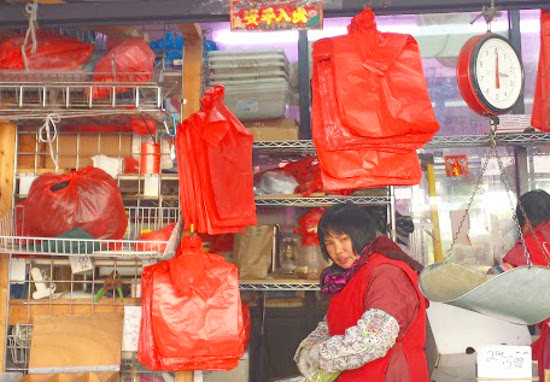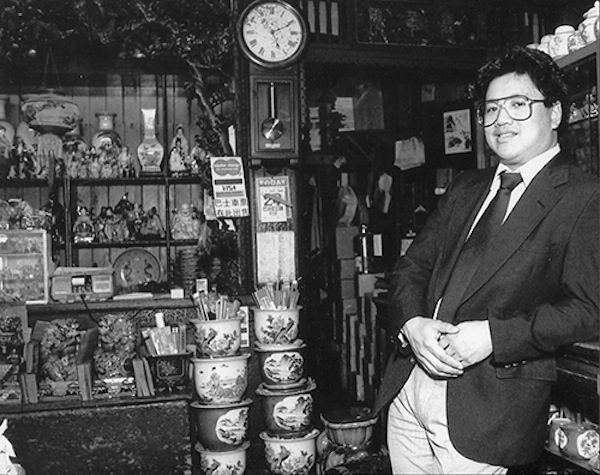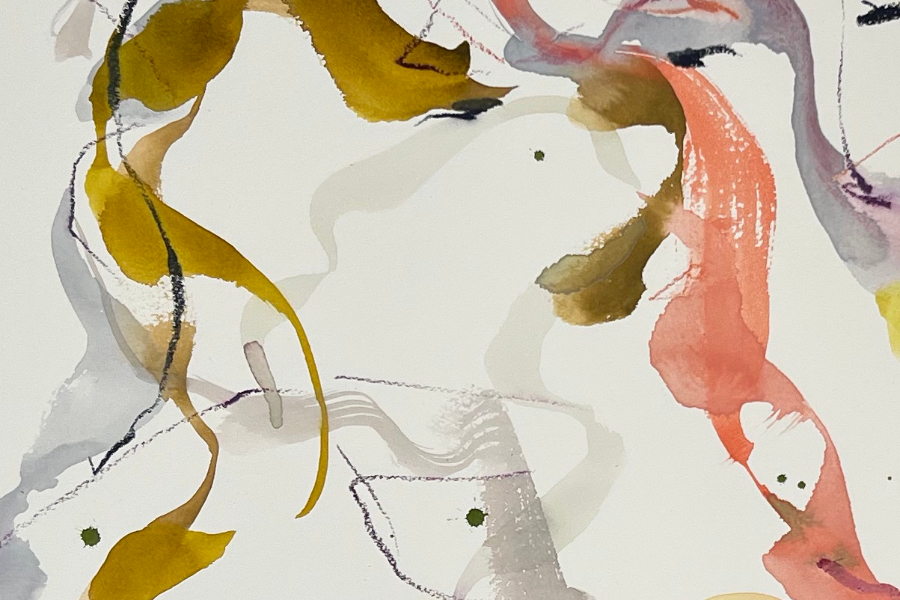A night in the life of nocturnal street artists and art vendors who, every midnight, take over the New York City neighborhood that literally doesn’t sleep.
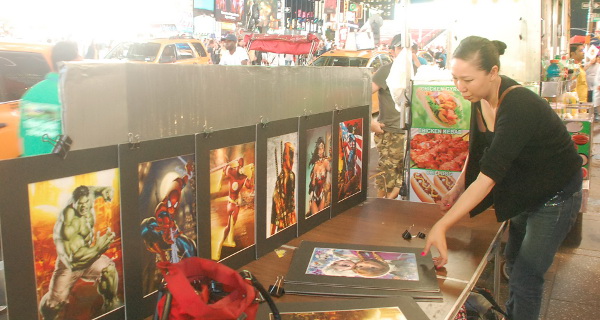
October 28, 2016
Read this story in Chinese here.
When the clock at the top of the Paramount Building on Times Square struck 11 one summer night of August 15, Lei Bai, who had been waiting on the sidewalk of nearby Seventh Avenue, sprang to action.
She lifted the two foldable vendor’s stands from her pushcart; hung a few dozens of colorful prints of images of cartoon figures, celebrities and iconic New York buildings on the handles of the stands with clippers; placed the price tags beside them—$1.99 for the ones the size of a paperback and $5 for the ones as big as a cutting board; and set up a tiny beach chair behind the stands for herself to sit on for the long night ahead.
In just three minutes, Bai was all set to greet her customers. After all, she has been doing this routine almost everyday for the past 12 years.
At the same time, the curb along the east side of Seventh Avenue between West 45th and 46th streets, which was clear just a few minutes ago, was completely transformed. Vendors and their stands completely covered every inch, every nook and cranny of this very valuable real estate.
Seventeen vendors were working side by side. Except for a hotdog and an ice cream seller, almost everyone out there was either a street artist or a vendor selling art products.
When I told Bai my tally, she grinned. There were two regulars missing that night, she said. “What? Two more? How are they going to fit in if they come later?” I asked.
“By squeezing,” Lei said matter-of-factly. But the street curb of that block, to my bare eyes, was already too crowded to squeeze in even a two-dimensional cartoon figure.
I realized I might be standing right in one of the most crowded street art blocks in New York City.
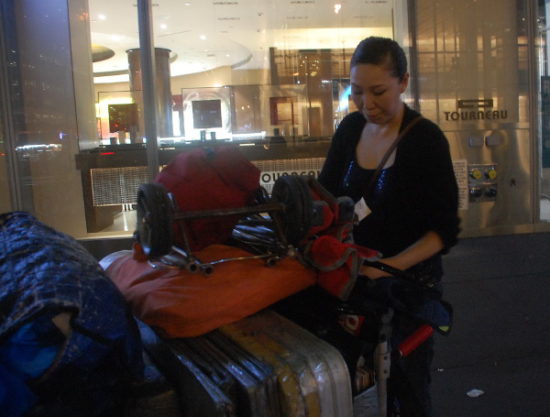
Times Square, an area of about 10 square blocks, is tiny compared to many other famous plazas in the world. But it is one of the strongest magnets for tourists from all over the world. With about 300,000 visitors every day, the density in this area is undoubtedly among the highest in New York City. People, together with their curiosities, aspirations and ambitions clash on the streets all the time.
No one knows this better than the street artists who come here everyday to make ends meet, not only because they see all the dramas on the street – but also because they themselves have to fight against one another for coveted spots, against the police over unreasonable tickets, and against their own selves who have to contend with the disparity between their dream of becoming the next Picasso and the reality of being a street artist.
No one knows exactly how many street artists there are working on Times Square. Unlike general vendors, artists or anyone selling art products are considered First Amendment vendors, who are not required to get permits from the city. That explains why there is no official statistics. Plus, street artists and vendors are highly nomadic. The number of street artists present on the curbs fluctuates with seasons and weather. Even advocate groups who work with them are not able to come up with an exact count.
Veteran vendors estimate there are 300 to 500 First Amendment vendors who set up their stands in the Times Square area. These estimates don’t include tip solicitors, like the men and women in costumes and the half-naked women, who don’t need stands. The vendors are from different countries and the majority is from China.
Not all vendors show up at the same time. Time restrictions on the streets mandated by the city reads like the arrival and departure billboard in an airport. One block could be open for vendors during daytime and the next one closed until midnight. The restrictions, regulated by the Department of Consumer Affairs, haven’t changed in at least a decade.
But for the vendors, life has been harsher since 2009 when then Mayor Bloomberg turned the perennially traffic-congested Broadway from 42 Street to 47 Street into pedestrian plazas.
“In the past few years, we lost five street curbs where we could set up stands because of the pedestrian plazas. At the same time, we saw more new immigrant vendors coming into this area,” said Bai.
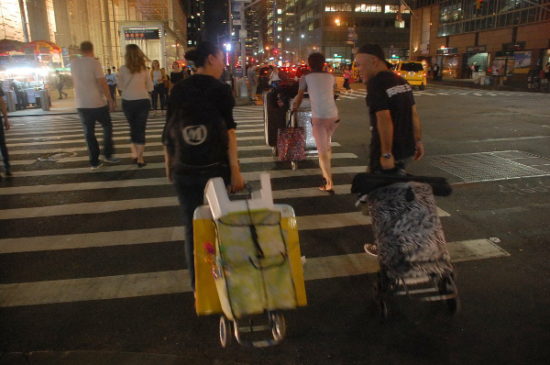
Whether vendors are allowed to set up stands on the plazas seems to be an arguable question. A spokesperson for the Department of Transportation, who has just assumed formal authority over pedestrian plazas last spring, said no. But Sean Basinski, director of The Street Vendor Project, an advocacy organization, said the city’s prohibition has no legal basis.
A few years ago, Basinski tried to mobilize the vendors to set up their stands on the plazas for a one-day event he called “reclaiming the plazas.” But the vendors, afraid of direct confrontation with the police, all stayed away. The event was dropped.
“It’s easy for us to say you have the right to be there. But my words don’t mean that much for someone who has to be out there to deal with the police everyday. In this power imbalance, it is easier to go and find another spot and make less money,” said Basinski.
Tim Tompkins, executive director of the Times Square Alliance, the entity that represents businesses on Times Square, plays down the effect of the plazas. “When Broadway was a street, there used to be a curb where in theory vending can happen because it’s a curb. But the overwhelming majority of hours of the day and days of the week (the vendors) were not allowed to be there,” said Tompkins.
But vendors working on the block where Bai normally set up her stand are clearly feeling the pinch. Located at the heart of Times Square and surrounded by iconic neon signs that make the night as bright as day, the block is the most coveted one among Times Square vendors. The west side of the road merges into a plaza, and therefore, is out of the question. And the time limits on the east side — from 11:00 p.m. to 8:00 a.m. Monday through Saturday and 24 hours on Sundays — make the space even more precious. By law, non-licensed vendors should take available spots on a first-come, first-served basis. But in reality, the law doesn’t solve all the complex issues.
“Before the pedestrian plazas were built, you can come anytime, and you’d get a spot. Starting five years ago, we have to get here really early to secure our spots,” said Ning Wang, a portrait artist who has been working on the block since 2000. There have been times when Wang, Bai and other vendors had to be there three hours before opening time to make sure they don’t lose their spots to some newcomers.
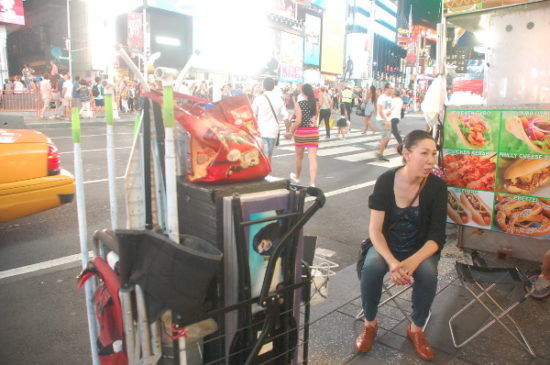
Those who were not able to grab a spot sometimes would aggressively set up their stands right in front of the others, igniting verbal, sometimes physical skirmishes. “There were always fights for spots. And police were called frequently,” said Wang.
In the recent years, after numerous brawls, shuffling and reshuffling, the regular vendors were able to obtain their regular spots by some common understanding. They still have to arrive before the opening time, just in case. But 40 minutes before 11 is good enough.
And the newcomers? There is basically no space for them on the block any more. “I never fought with anyone because I never go there to grab the hot spots,” said a Chinese portrait artist who wanted to be referred only by his last name Lim. Lim came from China two years ago, and he sets up his stand at the quieter 42nd Street close to Fifth Avenue.
Occasionally, a newcomer would be bold enough to set his or her foot on the block. Such adventure normally won’t have a happy ending. Just earlier this month, an Albanian vendor tried to squeeze in by placing his stand at the only unoccupied spot on the block—right in front of the garbage cans. Blocking garbage cans is illegal and it could draw the attention of the police to the block and expose everyone to tighter scrutiny. So the vendors fought against him together. Eventually he gave up. He remains in the area, as a pedicab driver.
On this particular steamy summer night though, the block looked peaceful. Everyone came within an hour before opening time and waited as quietly as possible, to avoid the attention of the police who sometimes shoo them away when they arrive before their time. Then, when it was time, the crowd – including a paint spray artist from Ukraine, a cap decorator from the Philippines, a few portrait artists and a name-painting artist from China, one portrait artist from Georgia and several others selling all sorts of crafts – all slid into their own spots uneventfully. Everyone knows which spot belongs to whom. No explanation needed. And they all know one another, although some are at best acquaintances.
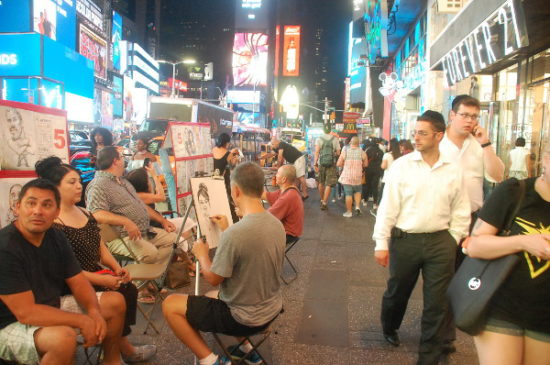
Bai is the only one who seems to be friends with everyone. Born in Changchun, China, Bai went to Japan for college where she studied kimono design and also learned photography from a famous photographer. She worked various jobs for more than 14 years in Japan before landing in the U.S. in 2003, when she was 32. A year later, struggling with English and badly needing a job, Bai took the advice of friend and joined the street vendors corps to sell her photo works.
A few years ago, with the growing popularity of iPhone and other smart phones, selling photographs started losing its appeal to tourists. Bai then decided to switch and start to sell mass-produced prints that allowed her to stay in business.
“I had never thought I would be doing this for so many years. But then I fell in love with the freedom and flexibility this job offers. It feels good to be your own boss,” Bai said.
Being out on the streets has made Bai street-smart. Her stand always has a sign that says “Last Day of Business,” a marketing trick she learned from many other small businesses in New York. She can always figure out what potential customers would like to hear and tell them exactly that, be it the weather or their appearances. And she gets to know and befriend everyone working around her.
On the night that I was following her as she moved from the corner of 42nd and Fifth Avenue to the golden block on Seventh, she said “hi” to every single vendor we bumped into on the way, and called most of them “sweetheart.” Even a horse carriage driver waved to her when he passed by her stand. She takes care of everyone, offering cigarettes to some and helping others buy bottled water from the hotdog stand at one dollar, which is half of the regular price. And the others take care of her, too. One vendor offered her iced water, another a bag of sliced mangoes. The ice cream vendor brought over an ice cream cone when he saw me standing with Bai. “A gift for your friend,” he told Bai.
But sometimes, Bai had to put up a stern face. When a black vendor a few stands away from hers left a cardboard box on the bike lane behind his stand, Bai rushed over to scold him. He muttered grumpily. But he obeyed and moved the box back on the curb. “That was dangerous,” Bai said. “It could cause an accident and draw the attention of the police to all of us.”
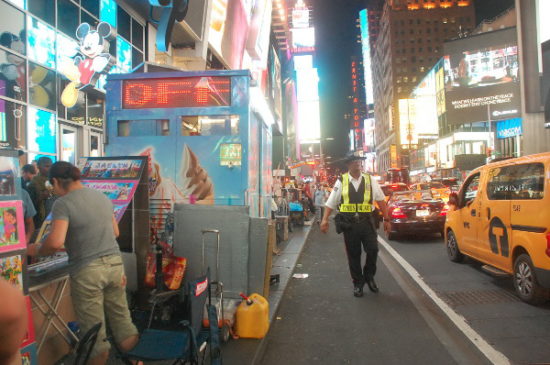
The police is arguably one of the biggest reasons that has pushed the vendors to close ranks and take care of one another. As the vendor from Geeorgia named Marika, who sells prints with her husband, told me when she came over to Bai’s stand for a cigarette break: “When we scream together at the police, oh my God, it’s head-splitting.”
Last time such a scene happened was a month ago, when a police officer ordered the vendors to leave at a time when the street should be open for them. The officer insisted the block belongs to Broadway, which was off the limit, rather than Seventh Ave. Bai, Marika and a few others held their ground firmly. They pointed the street sign that says “Seventh Avenue” The officer looked bewildered and said: “You guys put (the sign) there, didn’t you?”
It was an understandable mistake. Broadway and Seventh Avenue cross paths and cross each other right at 45 Street. The odd street layout confuses everyone from tourists to locals. But this is not the only problem on the block.
Falling into the jurisdictions of both Midtown North and Midtown South police precincts and the newly formed Times Square Unit of the New York Police Department, the block is one of the heaviest policed blocks in that area.
The city’s Byzantine regulations on street vendors, which, other than the time restrictions also include onerous details such as the height and width of a stand, and the different distances it has to be kept from the gates of the shops, the crosswalks, and fire hydrants, are not helpful. Even former police commissioner Bill Bratton called them “extraordinarily confusing and sometimes conflicting” in a press conference last year. It often happens the police officers enforcing the regulations do not know what the rules exactly are.
“One time, when I was setting up my stand at a spot, one officer came over, examined it and thought it was fine. Then, another officer came over and gave me a ticket for not keeping proper distance from something nearby. It’s very confusing,” said Qing Lin, a portrait artist.
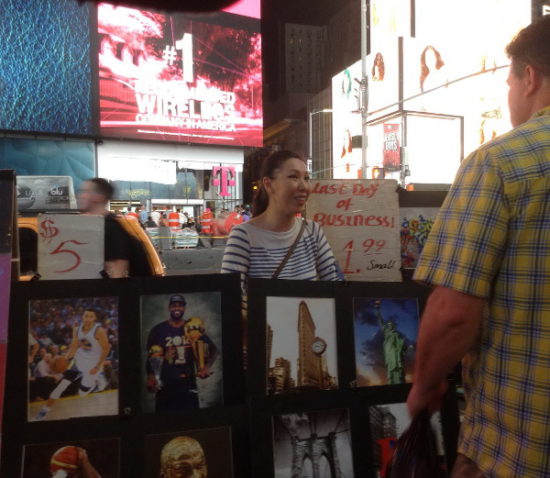
“We always got tickets for no particular reasons,” said Meifang Shi, a vendor selling grass crafts in Times Square who was once arrested and put in jail for two hours when she tried to videotape a police officer who she thought was giving her an unreasonable ticket.
Lin said when the vendors try to argue, the police often would flash a pair of handcuffs and ask: “Do you want to stay in jail or get a ticket?” “We Chinese are timid people in nature. Plus we don’t speak English well. When they show us the handcuffs, we are really scared and we stop arguing,” said Lin.
But the vendors have their own way of avoiding tickets. Some vendors would stop coming to their spots toward the end of the month. They believe the police tend to issue more tickets by the end of the month to meet their monthly quota. Some also stay away towards the end of the year, when, they say, fresh police academy graduates start to patrol and need to practice the skills of writing tickets.
Still, sometimes, things could be derailed from the regular track. For example, last summer when the aggression of some costumed workers and half-naked ladies drew the attention of the media, the city dispatched 100 extra police officers to patrol Times Square. The vendors, who had nothing to do with the issue, said there was a spike in the number of tickets issued from summer to autumn.
This triggered several rallies and marches by vendors, including Chinese street artists who didn’t have much experience in protesting against the authorities in their home country. “This is too much. I don’t want to continue working like this. But I am too old to find another job,” Junji Fu, a 60-year-old portrait artist who has been working at Times Square for 15 years, told me during one of these protests after he received five tickets in less than three months.
A spokesperson for the NYPD denied there is a quota requirement for officers. She said the police have been working closely with the vendors to clarify the regulations. Earlier this year, when the city passed the new law setting a designated area for the costumed workers, the police handed out educational materials to all vendors in that area to help them understand the law.
With the new law in place, the upsurge of tickets seems to have died down for now. But the vendors apparently haven’t recovered from the ticket-issuing rampage by the NYPD cops. Not too long ago, many of them were talking about a “new proposal” from the city aiming to close the entire 42nd Street 24/7 for the vendors.
“My phone suddenly started ringing off the hook. Everyone was calling to ask me whether that’s true,” said Bai. It turned out to be a rumor, which for anyone who can read in Elish, may be easy to tell. But for most of the vendors, most of whom face language barrier, that is not an easy task.
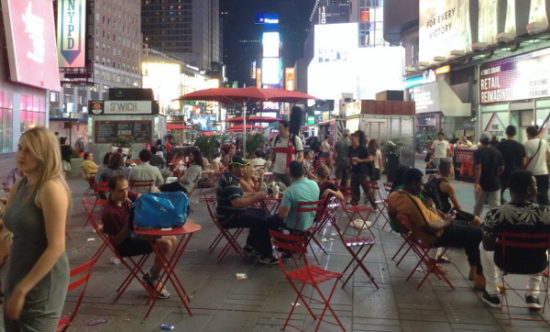
Still, to Jicheng Yao, the President of the Global Artist League, the situation for street artists is much better now than 24 years ago when he first came to the streets of Manhattan to draw portraits. “At that time, we were illegal,” said Yao.
As a newly arrived immigrant studying art at the City University of New York with no money to pay tuition, Yao saw some Chinese artists drawing portraits on the street to make money. He tried to join them. But he was not welcomed. No one would even tell him where to buy the artist stool that seemed to be perfect for this type of work. On the day he finally got all the tools needed and started working on the street, he was beaten up by a group of Chinese artists who were zealously protecting their territory.
Yao eventually fit in. But the police of the Giuliani administration had no mercy on street artists and considered them vending without license. “Every now and then, we would be arrested and thrown in jail for a few hours. In jail, the artists were put in the same cell and we had nothing to do. So every time we were there, we discussed what should we do to help ourselves,” said Yao.
One result of the jail cell meetings was the lawsuit Bery v. City of New York, in which a group of artists sued the city for impeding their First Amendment rights by requiring them to be licensed. In 1997, a federal court decision gave the artists the green light to work on the street without a license. It took a few more years of more lawsuits and appeals before the city completely accepted the court decision As a result, street artists do not need a business permit or license to do business on the streets.
But today’s street artists are different from Yao’s era.
In the 1980s and the 1990s, the Chinese artists who drew portraits on the street were mainly talented people trained in prestigious art institutes in China. Many of them see being on the streets as a stepping stone to get closer to their artistic dream. They all wanted to be like Ai Weiwei or Chen Danqing, who went back to China after working a few years in Times Square in the 1980s and became world-renowned artists. Or at least to be like Wei Xiao, whose legacy everyone still talks about with respect, even though he no longer comes out on the street.
Xiao, or Yo-Yo, as he is known on the street, graduated from the Central Academy of Fine Arts in China. He started to draw portraits on Times Square in 1998. Facing sharp competition, Xiao quickly realized he had to do something different from everyone else.
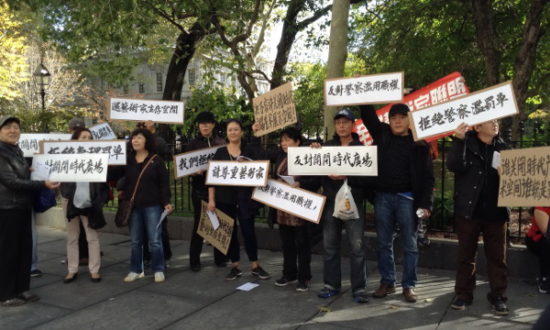
One day, on a subway train, Xiao got his aha moment when he picked up a cardboard on the train seat and found an illustration of Mickey Mouse printed on the face. “I thought the eyes of Mickey Mouse are disproportionally big. But they are cute. So people like them,” said Xiao, in a phone interview in August.
He started to adopt a caricature style into his portraits. The tourists immediately fell in love with it. “It’s simple. It’s cute. And it’s funny. Once a client laughed too hard when he saw his images in caricature so he rolled on the ground. The police rushed over to see what was going on,” said Xiao.
Now the caricature style Xiao invented is the most popular one among Times Square artists. But he’s no longer doing it. “An artist’s mission is to create something new for the world,” said Xiao who, in recent years, has been focusing on experimenting a new computer-assisted art form while supporting himself selling construction material.
Yet many of the street artists see themselves stuck on the street. With each passing year, they feel their dreams fading away. And then they have to work in afield that gets crowded everyday, as more new immigrants who hastily pick up some basics drawing skills and join them on the streets.
This creates acrimony. “The formally trained people spent years learning this. The others have no training at all. Now they work side by side. By our standards, they don’t know what’s art. But they are more aggressive in soliciting customers. So they often have better business,” said Yao, who no longer works on the street these days.
Then the pain is further exacerbated by the traditional Chinese “losing face” issue. In Chinese culture, working on the street is not considered a decent job. And in Chinese language, the word “artist” mainly refers to those who work in a studio and deal with galleries and museums. For those who see little hope in themselves getting there, working on the street could be considered as a shame.
Lin, the portrait artist working on 42nd Street, told me he once set up his stand beside a Chinese fellow who used to be a professor at an art college in China. One time when business was slow, the two started chatting. The professor was spotted by a group of Chinese tourists who happened to be his former colleagues in the college. “He turned his head away. But it was too late. They asked him why he was there. He told them he was there to visit me, a friend. And I had to cover for him,” Lin said.
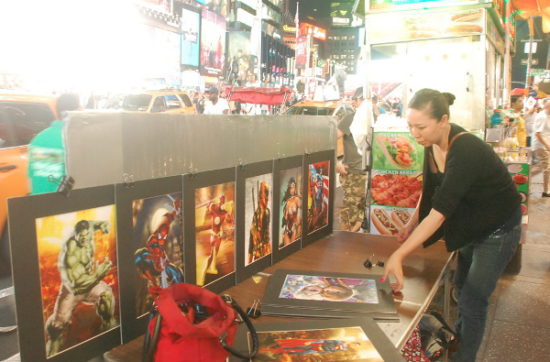
When I interviewed an artist who only gave his last name Wang, I felt this “loss of face” agony first-hand. Wang, a graduate from Lu Xun Academy of Fine Arts, asked me to not take his picture because he doesn’t want his wife, who is still in China, to see him working on the street. “Doesn’t she know you make a living by doing art?” I asked. “She does. But she doesn’t know where,” said Wang.
Bai understands the sensitive feelings of her peers. But she herself has no such problem. “This is New York. Street is just an open museum,” said Bai.
But she has her fears. She was scared when the vendor close to her stand fought with a drunken customer and knives were flashed. And she is worried about terrorist attacks, to which Times Square would be a natural target. “I keep my eyes alert all the time,” she said.
That night on August 15 was a slow one. By midnight, the Ukraine spray painter started to roller skate on the bike lane. “No customers,” he complained.
This summer is not good. May be the Rio Olympics steals tourists from our streets,” said Bai. “I doubt whether New York will get 50 million visitors by the end of this year.”
By 1:30 a.m., when Times Square finally was getting quiet, Bai wrapped up her stand. She left her pushcart in a nearby storage, for which she pays $140 per month. Before she descended to the subway station to go back home in Bensonhurst, I asked her what’s her immediate dream. She answered without hesitation: “I hope the heat wave is over tomorrow.”
The day before, a Sunday, when the block was open for the whole day, she worked in the 90-degree heat for 16 hours.
(This story also came out in Chinese in the online edition of Sing Tao Daily.)

